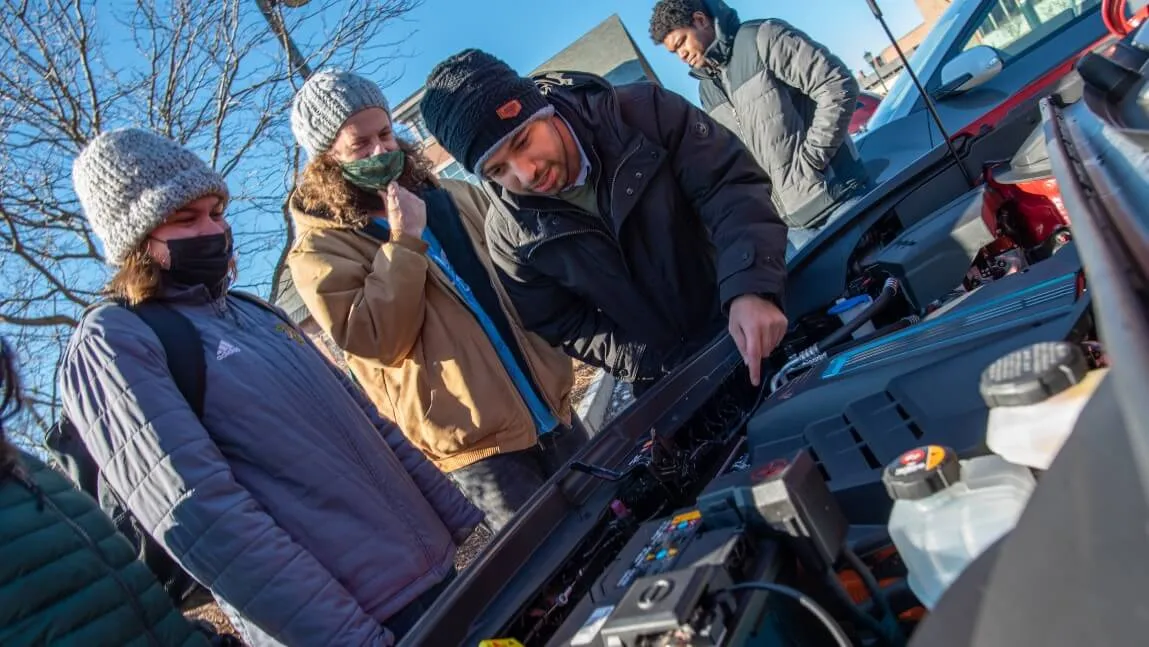UVM community members and curious passersby, including a group of prospective students guided by a UVM AdvoCat tour guide, got a close look at a fleet of electric vehicles (EVs) in the traffic circle outside the Dudley H. Davis Center Friday afternoon.
Some took advantage of an opportunity to climb into the driver’s seat of an EV and take a few spins around the traffic circle during the “Ride and Drive” event. Others gathered to hear more about the benefits—personal and environmental—of going electric.
Jim Barr, director of UVM transportation and parking services was one of the people on hand to answer questions. He’s charged with converting the UVM fleet to electric and low emission vehicles, wherever possible.
“I’ve been at UVM for 12 years and I’ve been at this for the last 10,” Barr said. “I work with departments or anyone on campus who purchases vehicles to consider going electric instead of the big, old gas vehicle.”
Sustainable Transportation Program Manager Abby Bleything described how UVM is facilitating the growing number of EV drivers. “In 2016 we didn’t have any charging stations on campus. Now we have 18 different ports in eight different locations,” she said.
This new capacity came in part through partnerships with local entities like Burlington Electric, one of the event organizers. In 2014, Burlington became the first city in the country to source 100% of its electricity from renewable energy.
“The city of Burlington has a quest to achieve net zero energy by 2030,” said Jen Green, director of sustainability for Burlington Electric. “That essentially means we have to transition away from fossil fuels.”
The collaboration provides an example of how public utilities and UVM are working together to encourage and deploy electric vehicle technology. The locations of on-campus charging stations were based on research conducted with students, faculty and staff. Burlington Electric managed and funded the installations.
Representatives from Green Mountain Power, another Vermont utility which helped organize the event, were on hand to promote $1500 customer rebates for a new all-electric vehicle, or $1,000 for a new plug-in hybrid (PHEV). Vermont Clean Cities (housed in UVM’s Transportation Research Center) also co-hosted the event.
UVM Sustainability Director Elizabeth Palchak points out that shifting to electric vehicles is crucial for reducing greenhouse gas emissions in the state.
“In Vermont, the majority of our emissions come from the transportation sector, so purchasing an electric vehicle for your home or fleet has the potential to make an impact—and they’re fun to drive!”
Palchak, herself a plug-in hybrid owner, notes that the recently released Vermont Climate Action Plan identifies the shift to electric vehicles as a key step in reaching short and long-term emissions reductions goals. By 2030, Vermont is striving to get 160,000 light electric vehicles on the road.
Organizers pointed out the many advantages of driving electric, including low maintenance, cheap refueling costs and the societal benefits of healthier air and lower carbon emissions. One of the primary obstacles for consumers—the up-front cost of buying an EV—are increasingly being offset through federal tax credits and incentives offered by state and local government and utilities.
Also present for the event was Enrique Corredera, who offered rides in his 2020 Chevy Bolt EV. Corredera was there partly in his official capacity as UVM’s executive director of news and public affairs, but also because he is an enthusiastic convert to EV transportation.
He invited visitors to look under the hood, revealing clean components free of any oil and grease stains. “It’s incredibly easy to drive and maintain,” said Corredera, who uses the vehicle to commute each day from his home in Charlotte. “Most things that go wrong with a gas-powered engine—fuel pumps, emission control systems, spark plugs—you don’t have those maintenance issues with an EV.”
Corredera pointed out other benefits of driving electric. “On cold winter days I can start it from my office using the phone app and by the time I get to the car the cabin is warm and the ice and snow are melted off the glass, all without idling or carbon emissions,” he said. “And on hot summer days I can leave the dog inside the air-conditioned cabin while I’m grocery shopping after a hike. I display a sign to let people know he is very comfortable in there.”
Even compared to hybrid vehicles, which run on a combination of electricity and conventional fuel, Corredera’s Bolt is unnervingly silent. It creeps back out of its parking spot then, ghostlike, speeds away without the rumble and roar we associate with conventional modes of ground travel.
“So quiet,” exclaims an observer.
